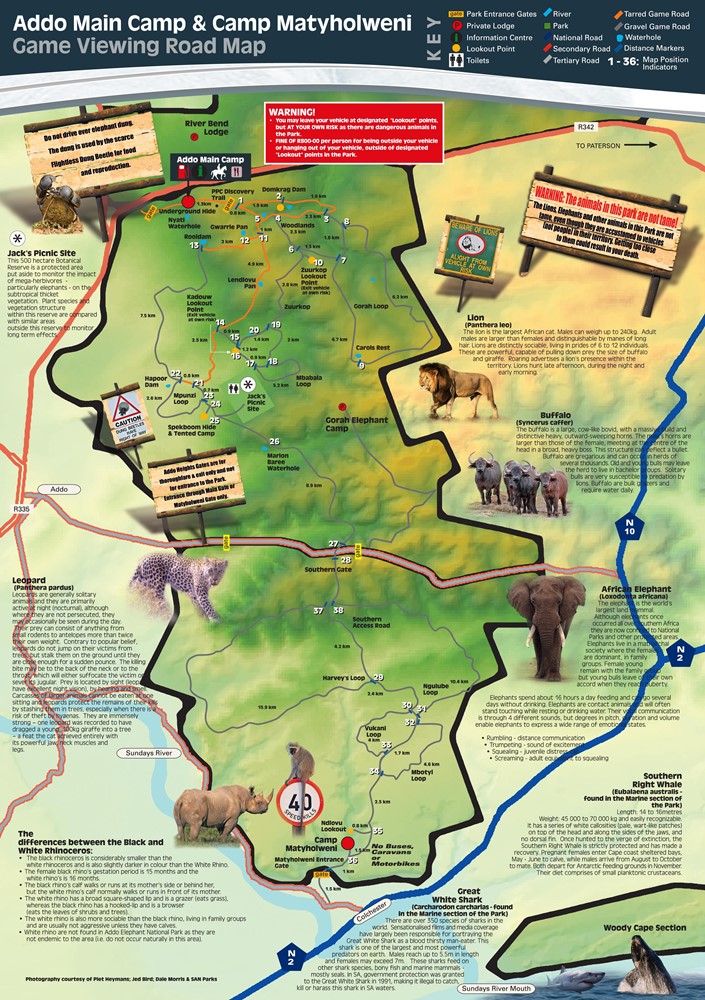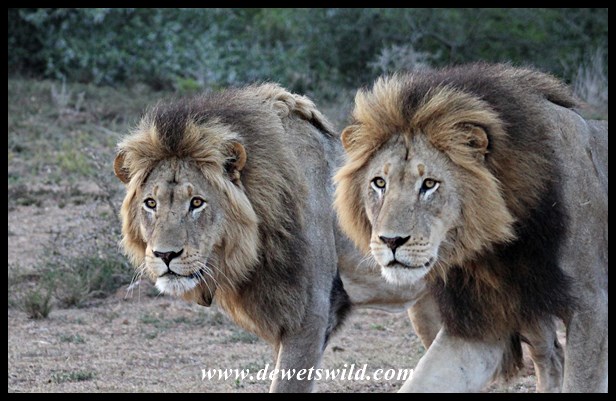Today we celebrate the 90th birthday of the Addo Elephant National Park.
By the early 1900’s the Eastern Cape’s wildlife was being exterminated at an alarming rate. The last remaining lions and black rhinos in the region did not see the arrival of the year 1900, and only about 140 African Elephants remained around the Addo district, which was rapidly developing into an important agricultural area, leading to conflict with the newly established farmers. The government’s decision to intervene was not good news for the elephants. In 1919 they appointed Major P.J. Pretorius to destroy the elephants, and by 1920 he had killed 114 of them and caught 2 for a circus. Only 16 elephants remained when public sentiment swung in their favour and the wanton killing ended, and when the Addo Elephant National Park was proclaimed on 3 July 1931, only 11 elephants were left. Initially, the Park was not fenced to keep the elephants in and when they left the Park they were at the mercy of the “civilisation” that wanted to destroy them all, so the first Park manager made the decision to feed them with citrus and other fresh produce to keep them within his boundaries. Slowly but surely their numbers started growing, but by the time the Park, then only 2,270 hectares in size, was finally surrounded with an elephant-proof fence in 1954, there was still only 22 elephants at Addo. The unnatural practice of feeding the elephants, which in the end was done more for the entertainment of tourists than for the elephants’ sake, ended in 1979. By then the herd numbered about 100 animals, but Addo’s elephants have responded wonderfully to the protection they’ve been afforded since the Park’s proclamation, and today number over 600! Along with the elephants, the last free-roaming herds of African (Cape) Buffalo that occurred in the then Cape Province, as well as the unique and endemic Addo Flightless Dung Beetle, finally found a secure refuge. In subsequent years the Park’s area was expanded and species that fell into local extinction were reintroduced.
With the Addo elephants now finally living in a safe refuge, the focus at Addo Elephant National Park is no longer on saving a single species. Today, the park’s management is concerned with the protection of the enormous diversity of landscapes, flora and fauna encompassed within its boundaries, which covers an expansive area of over 178,000 hectares stretching from beyond and across the Zuurberg range to the coastal forests and dune fields of Alexandria. The Park protects portions of no less than five of South Africa’s seven distinct terrestrial biomes, these being subtropical thicket, fynbos, forest, grassland and Nama-Karoo, not to forget to mention the portion of marine environment protected around Algoa Bay’s St. Croix and Bird islands which is important breeding sites for endangered seabirds. Addo is the only National Park in South Africa that can claim to protect the “Big Seven” – the famed “Big Five“ of Elephant, Lion, Black Rhino, Buffalo, Leopard, together with the Great White Shark, and Southern Right Whale.
Addo Elephant National Park protects a total of 95 mammals species. The Park also boasts a list of 417 bird species, and if that isn’t enough, visitors also have a chance of spotting any of the more than 50 reptile species or 20 kinds of frogs and toads that call Addo Elephant National Park home. The Park’s most famous invertebrate inhabitant undoubtedly is the Addo Flightless Dung Beetle (Circellium bacchus), this being only one of 5 places they are still found. These interesting insects make use of elephant and buffalo dung as food, either for themselves or rolled into brood balls in which they lay a single egg before burying it in soft sand and on which the larvae then feeds when it hatches.
The Addo Main Camp is the Addo Elephant National Park’s first and biggest tourist facility. Camping and a wide variety of accommodation (as well as a swimming pool) is available to overnight guests. There are picnic sites for day visitors, an underground hide overlooking a waterhole frequented by all the Park’s animals and floodlit at night (we even saw a brown hyena there when we visited in December), a birdwatching hide overlooking a small artificial wetland, a self-guided discovery trail, guided drives and horse rides, a fuel station, restaurant, shop and excellent interpretive centre where young and old can learn more about the Park and its inhabitants. Elsewhere in the Park guests can overnight at the luxury, full service and privately-run Gorah, Riverbend and Kuzuko-lodges, or in one of the Park’s own camps at Nyathi, Matyholweni, Kabouga Cottage, Mvubu Campsite, Narina Bushcamp, Langebos and Msintsi. Between the Main Camp and Matyholweni guests have access to an extensive and well-maintained network of all-weather game viewing roads, while other areas of the Park can be explored along hiking trails or 4×4 trails.
The easiest way to reach the Park is along the N2 highway from Gqeberha (formerly Port Elizabeth), turning off to the gate at Matyholweni just before you reach the small town of Colchester on the bank of the Sundays River, about 45km from PE’s airport.


Addo map from https://www.sanparks.org/parks/addo/tourism/map.php







































Thanks for the very interesting history of Addo and paying it such a lovely tribute with your variety of great pics.
LikeLiked by 1 person
Thank you very much, Carol. Addo’s story gives me hope that we might learn to stop and reverse the harm we continue to do to our planet.
LikeLiked by 1 person
Indeed it does provide good reason for hope.
LikeLiked by 2 people
Wow! What an absolutely amazing place!
LikeLiked by 1 person
These pictures hardly does Addo justice, Kathy. It’s one of the jewels in South Africa’s crown.
LikeLiked by 1 person
I must go down to Addo again, to see the sea and they sky – filled with birds of every hue that fly above animals that graze and browse and nibble before drinking, rolling in the mud, chasing each other – or which lie in wait … for a sustaining meal. The picnic place is taped off once more – thank you Covid – but nothing stops one enjoying a picnic at one’s vehicle.
LikeLiked by 1 person
Addo does inspire the poet inside, doesn’t it, Anne!?
LikeLike
It does and … if all goes well … I might be waxing lyrical about the MZNP before long 🙂
LikeLiked by 2 people
I am holding thumbs for your trip to MZNP to go ahead unimpeded, Anne. We might have to live vicariously through you – the 11th of July is looming large with that infection % still rocketing upwards, and with it any escape from Gauteng becomes ever more unlikely this winter.
LikeLiked by 2 people
Ek is mal oor Addo!
LikeLiked by 1 person
Is dit nie n wonderlike plek nie, Toortsie!?
LikeLiked by 1 person
Beslis
LikeLiked by 2 people
Kudos to all the people who have worked so tirelessly on wildlife and habitat conservation.
LikeLiked by 1 person
Today Addo Elephant National Park stands as their monument!
LikeLiked by 1 person
The best kind of monument you could wish for.
LikeLiked by 2 people
I tip my hat to all the people that made this possible, now, we have animal preservation and kept safe from extermination. Great post, D. 🙂
LikeLiked by 1 person
I’m sure the many generations of dedicated people that worked for the conservation of Addo and its inhabitants will receive your congratulations gratefully, H.J.
LikeLiked by 1 person
It’s always a joy to read good news like this, Dries, especially when it comes to preserving animals and habitat. Wonderful photos as usual. The sunbird and dung beetle shots really caught my attention, though.
LikeLiked by 1 person
This really is a milestone worth celebrating, especially in these trying times where good news are often hard to find.
LikeLiked by 1 person
I cannot imagine, in my wildest dreams, someone deciding it is OK to kill elephants. Kudos to Addo. The photo of the Kings of Addo is beautiful.
LikeLike
I agree with you wholeheartedly, Lois, but sadly people like that still share this planet with you and me, and the elephants.
LikeLike
Glad to see your comment that the goal now is protecting all of the wildlife in the park. As always, you post photos of a wide variety of your continent’s native wildlife.
LikeLike
Thanks very much, John. Addo is a wonderful example of how protecting one key species allows the whole ecosystem to be conserved.
LikeLiked by 1 person
Judging from what little I have read, most of the problems with diminishing elephant population stem from ivory poachers. It may be where “hunters” want to practice their skills in the same way that early North American hunters eliminated the bison population. I can’t even guess why the other animals would become extinct?
LikeLike
Indiscriminate hunting for “sport”, ivory and meat during and after colonial times had a terrible impact, Beth. Thanks goodness our country moved in the right direction before it was too late with the proclamation of places like Addo.
LikeLike
A nice story and beautiful photos. 😀
LikeLiked by 1 person
Thank you very much, John!
LikeLike